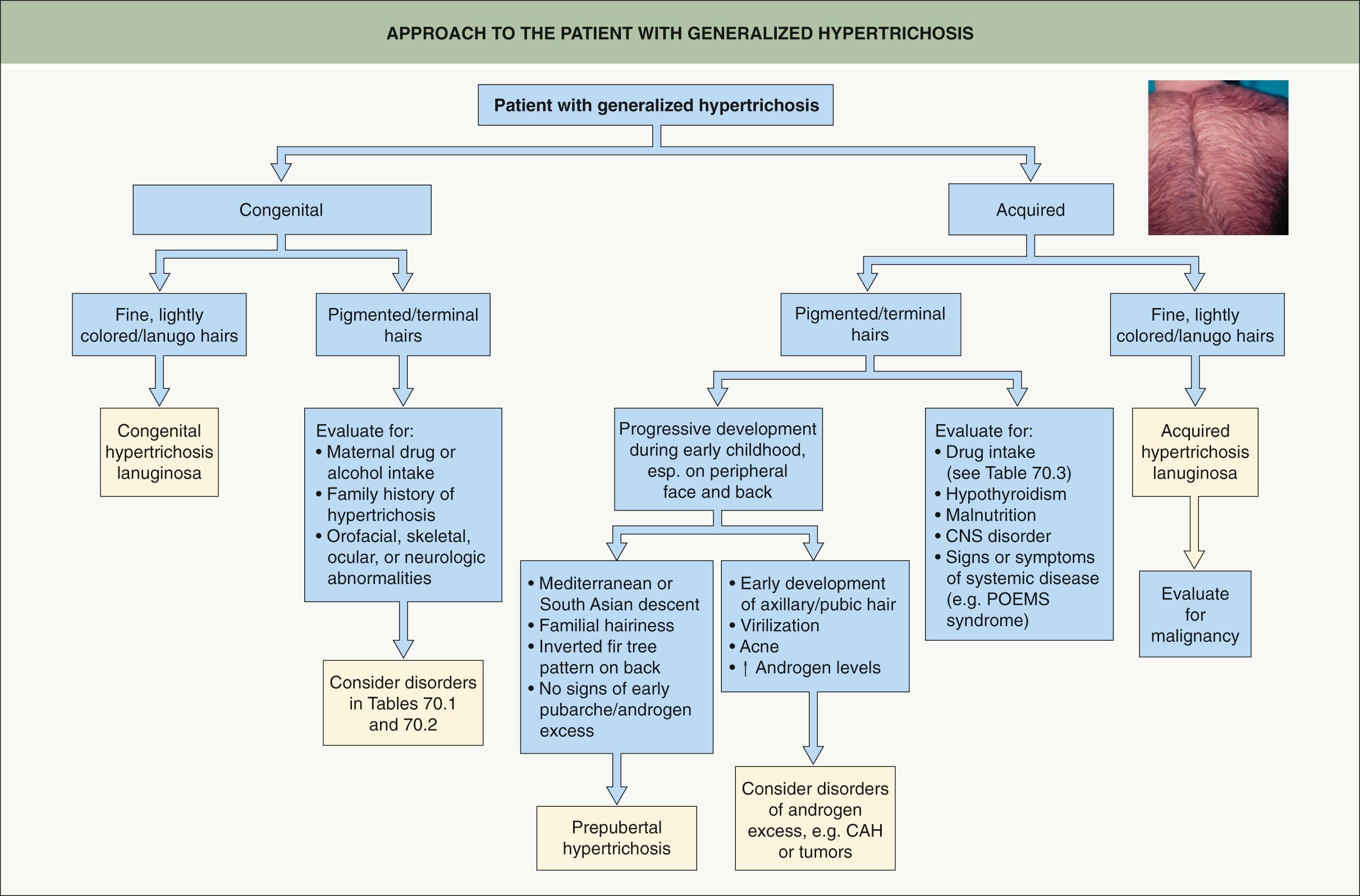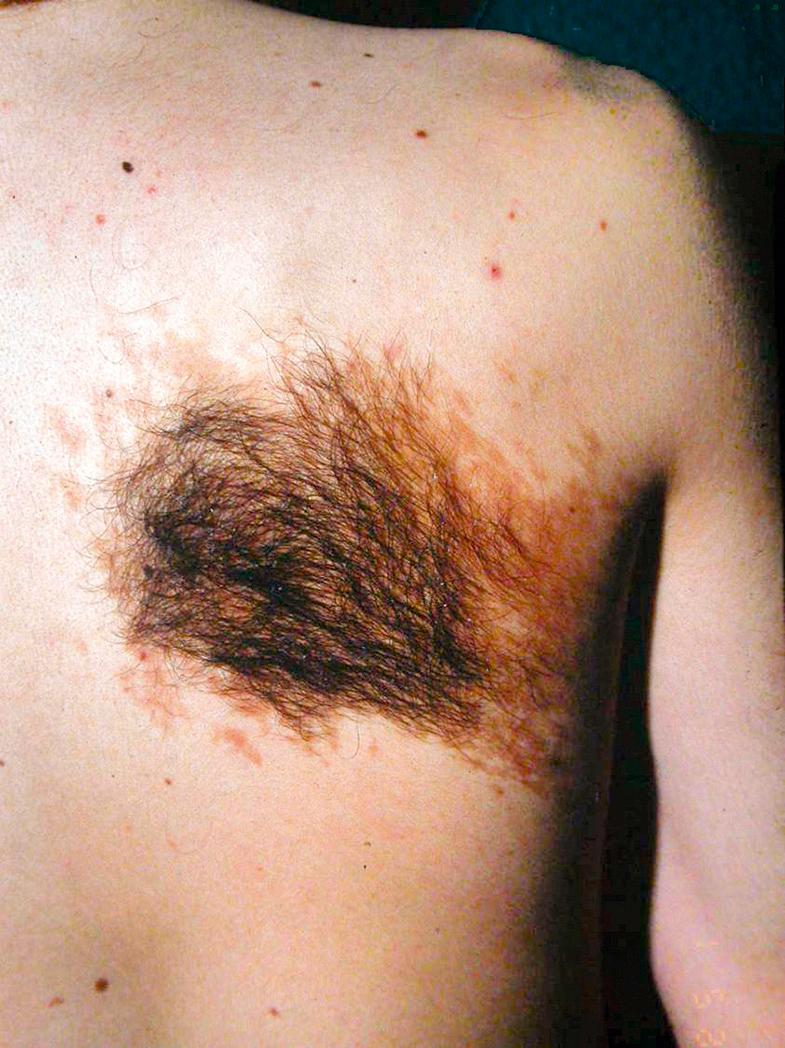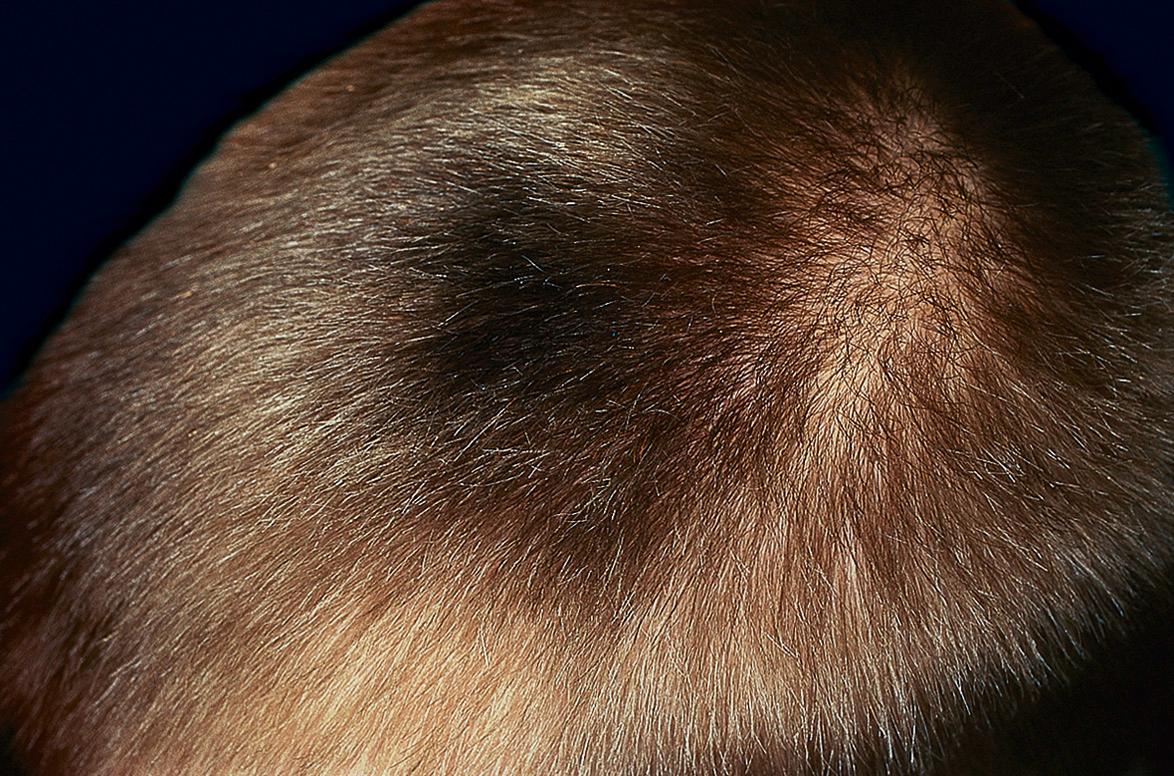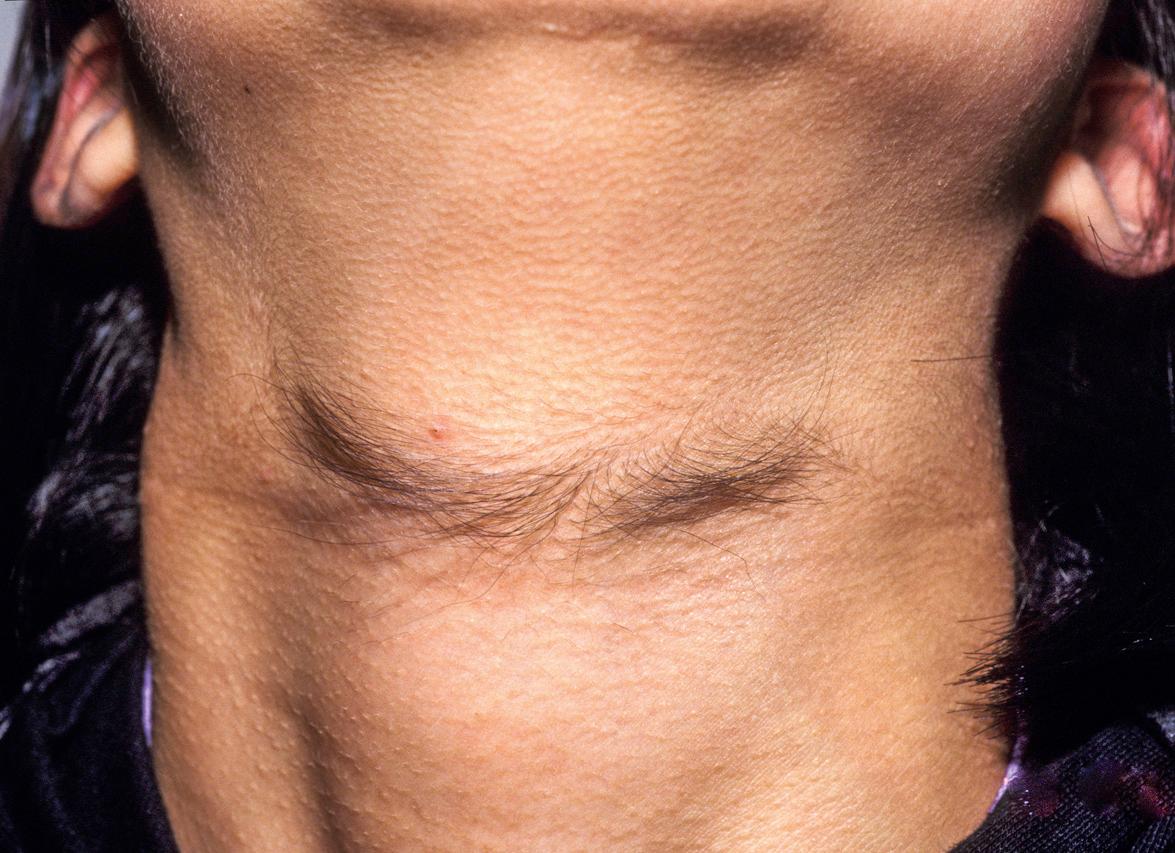Physical Address
304 North Cardinal St.
Dorchester Center, MA 02124
Hypertrichosis refers to excessive growth of hair anywhere on the body, whereas hirsutism represents excessive hair growth within androgen-dependent sites in girls and women
Hypertrichosis may be generalized or localized, with etiologies ranging from genodermatoses to underlying hamartomas to repeated trauma
Hirsutism is related to hormonal factors, in particular an increase in circulating androgen levels and/or enhanced sensitivity of hair follicles to androgens
In women, the major sources of androgens are the adrenal glands and the ovaries; dysfunction of these organs must be considered when a patient presents with hirsutism
Depending on its etiology, treatment of hirsutism includes antiandrogens, glucocorticoids, insulin-lowering agents, and/or contraceptives, combined with topical medications and physical measures (e.g. laser hair removal)
Hypertrichosis describes the growth of excessive hair anywhere on the body. The term is frequently confused with hirsutism, which should only be applied to women with excessive growth of terminal hairs in androgen-dependent sites (i.e. a “male pattern”) due to hyperandrogenemia or increased end-organ sensitivity to androgens . Hypertrichosis can be classified based on its distribution (generalized versus localized), the age of onset (congenital or programmed from birth versus acquired), and the type of hair (lanugo or vellus versus terminal).
In generalized hypertrichosis, there is lanugo hair, excess vellus hair, or terminal hair over much of the cutaneous surface, including an acquired transformation of terminal hair into lanugo hair ( Fig. 70.1 ) . Lanugo is the non-pigmented, non-medullated, fine hair that covers the fetus and can grow up to several centimeters in length; it is normally shed in utero or during the first few weeks of life and replaced by vellus hair on the body and terminal hair on the scalp. Age of onset can vary from infancy to prepubertal to adulthood.

A number of distinctive but rare genetic syndromes are associated with congenital generalized hypertrichosis ( Table 70.1 ). While the majority of these disorders have extracutaneous manifestations such as gingival hyperplasia or facial dysmorphism, some have primarily hypertrichosis, including universal hypertrichosis. However, this latter entity is sometimes viewed as constitutional, i.e. simply exaggerated normal hairiness that may be familial. Genetic abnormalities associated with congenital generalized hypertrichosis lead to dysfunction of several proteins, ranging from those known to be involved in hair follicle development to membrane transporters (see Table 70.1 ).
| HEREDITARY DISORDERS CHARACTERIZED BY CONGENITAL GENERALIZED HYPERTRICHOSIS | ||
|---|---|---|
| Disorder | Inheritance (locus; genetic basis) | Other key features |
| Increased hair is the major feature | ||
| Congenital hypertrichosis lanuginosa | AD |
|
| Universal hypertrichosis | AD |
|
| Ambras syndrome (hypertrichosis universalis congenita, Ambras type; HTC1) | AD (8q22–q24 breakpoints; position effect down-regulates TRPS1 expression) |
|
| Generalized hypertrichosis with extracutaneous features | ||
| X-linked hypertrichosis (congenital generalized hypertrichosis; HTC2) | XLD (Xq27.1; palindrome-mediated interchromosomal insertion; position effect down-regulates FGF13 expression) |
|
| Congenital generalized hypertrichosis with or without gingival hyperplasia (HCT3) | AD or AR (17q24.2–q24.3 microdeletion or microduplication [AD]; position effect down-regulates SOX9 expression; also ABCA5 mutations [AR]) |
|
| Cantú syndrome (hypertrichotic osteochondrodysplasia) | AD (12p21.1; ABCC9 mutation) |
|
| Zimmermann–Laband syndrome 1 & 2 |
|
|
| Coffin–Siris syndrome 1–5 ** |
|
|
| Schinzel–Giedion midface retraction syndrome | AD (18q12.3; SETBP1 mutation) |
|
| Gorlin–Chaudry– Moss syndrome |
AR vs XLD |
|
| Adducted thumbs syndrome | AR |
|
| Barber–Say syndrome | AD (2q37.3; TWIST2 mutation) |
|
| Amaurosis congenita, cone–rod type, with congenital hypertrichosis ‡ | AR |
|
| CAHMR syndrome ‡ | AR |
|
* This pattern of distribution is also observed in prepubertal hypertrichosis (see text).
** Protein products of mutated genes are subunits of the SWI/SNF complex.
The possibility of intrauterine exposure to medications (e.g. minoxidil) also needs to be considered in infants with congenital generalized hypertrichosis. The differential diagnosis also includes inherited disorders in which hypertrichosis can involve multiple sites and may appear early in life ( Table 70.2 ).
| HEREDITARY DISEASES AND CONGENITAL SYNDROMES ASSOCIATED WITH REGIONAL HYPERTRICHOSIS | ||
|---|---|---|
| Disorder | Sites of hypertrichosis | Other key features |
| Dysmorphic syndromes | ||
| Cornelia de Lange syndrome 1–5 |
|
|
| Rubinstein–Taybi syndrome 1 & 2 |
|
|
| Disorders with primary cutaneous features | ||
| Porphyrias |
|
|
| Lipodystrophy syndromes (e.g. Berardinelli–Seip syndrome, leprechaunism) |
|
|
| Erythrokeratodermia variabilis |
|
|
| Dystrophic epidermolysis bullosa * |
|
|
| Ichthyosis bullosa of Siemens * |
|
|
| Metabolic disorders | ||
| Mucopolysaccharidoses † |
|
|
| Congenital hypothyroidism |
|
|
| Mitochondrial disorders | ||
| Leigh syndrome due to SURF1 mutations |
|
|
| MELAS syndrome |
|
|
| Intrauterine exposures ‡ | ||
| Fetal hydantoin syndrome |
|
|
| Fetal alcohol syndrome |
|
|
| Morpheaform or sclerodermoid disorders | ||
| MONA (multicentric osteolysis, nodulosis, and arthropathy; previously known as Winchester syndrome) |
|
|
| H syndrome § , |
|
|
| Stiff skin syndrome |
|
|
| Linear melorheostosis (isolated melorheostosis) ¶ |
|
|
* Hypertrichosis is an uncommon feature.
† Hypertrichosis may also be observed in other lysosomal storage diseases, e.g. Krabbe disease and GM1-gangliosidosis, as well as sialuria.
‡ Also minoxidil and diazoxide.
§ Allelic with pigmented hypertrichosis with insulin-dependent diabetes mellitus (PHID) syndrome, sinus histiocytosis with massive lymphadenopathy (SHML), and Faisalabad histiocytosis.
¶ Hypertrichosis has also been described overlying linear scleroderma in the absence of melorheostosis.
Prepubertal hypertrichosis is a relatively common finding in otherwise healthy infants and children, most often occurring in individuals of Mediterranean or South Asian descent. Pigmented hair is present in a widespread, diffuse distribution and becomes more obvious during childhood. There is involvement of the face (especially the forehead, temples, and preauricular area), proximal extremities, and back; hairs in the latter location assume an “inverted fir tree” pattern. Bushy eyebrows and a low anterior hairline represent additional features.
The facial distribution pattern of prepubertal hypertrichosis can overlap with that of familial hirsutism (see below), and there may be a family history of excessive hairiness. Mildly elevated levels of total and free testosterone have been observed in a subset of girls with prepubertal hypertrichosis, while others have a normal androgen profile . These findings suggest multiple etiologies for this clinical pattern of hypertrichosis, including androgen excess as well as an increased constitutional propensity for hair growth.
Acquired generalized hypertrichosis is most often related to drug ingestion ( Table 70.3 ). Drug-induced hypertrichosis is characterized by slow growth of terminal hair of medium thickness. The findings are most evident on the forehead, temples, flexor aspects of the extremities, and trunk. Drug-related hypertrichosis is usually reversible, and differs in distribution from drug-induced hirsutism.
| HYPERTRICHOSIS DUE TO DRUGS | |
|---|---|
| Antibiotics | |
|
|
| Anti-inflammatory drugs | |
|
|
| Vasodilators | |
|
|
| Diuretics | |
|
|
| Anticonvulsants | |
|
|
| Immunosuppressives | |
|
|
| Psoralens | |
|
|
| Antiseptic agents | |
|
|
| Chelators | |
|
|
| Other | |
|
|
Acquired generalized hypertrichosis can also represent a sign or consequence of a variety of systemic conditions, including disorders of the CNS (e.g. traumatic brain injuries), juvenile hypothyroidism, juvenile dermatomyositis, acromegaly (especially of the lower face), malnutrition (including anorexia nervosa), POEMS syndrome, and advanced HIV infection.
This is considered to be a paraneoplastic phenomenon as it is associated with internal malignancies, most often of the lung, colon, or breast. Occasionally, acquired hypertrichosis lanuginosa may precede the diagnosis of the neoplasm. In addition, it may be associated with other paraneoplastic dermatoses, such as acanthosis nigricans, palmoplantar keratoderma, the sign of Leser–Trélat, and acquired ichthyosis (see Ch. 53 ). The lanugo hair appears over the entire body within a short period of time, although in mild forms it may be localized to the face, leading to a “simian” appearance. Lanugo hair may even develop in areas of androgenetic alopecia.
Most cases of localized hypertrichosis involve a switch from vellus to terminal hair in sites that do not usually bear terminal hair. Localized hypertrichosis can develop as a component of a hamartoma, as an isolated congenital lesion, as a manifestation of a systemic disease (inherited or acquired), or as a consequence of cutaneous trauma or inflammation.
Hamartomas, including those with delayed clinical presentation, and congenital abnormalities characterized by hypertrichosis of a specific anatomic site ( Fig. 70.2 ; Tables 70.4 & 70.5 ) are included in this category.

| HEREDITARY HYPERTRICHOSIS AFFECTING SPECIFIC ANATOMIC SITES | |||
|---|---|---|---|
| Condition | Inheritance | Onset | Other features |
| Hypertrichosis cubiti (hairy elbow syndrome; Fig. 70.2 ) | AD | Birth to early childhood |
|
| Hairy palms and soles | AD | Birth | |
| Hypertrichosis of the auricle | AD † | Childhood or adolescence |
|
| Hypertrichosis of the eyebrows | ? | Adolescence | |
| Trichomegaly of the eyelashes | AR | Childhood | |
| Hypertrichosis of the nasal tip | ? | Adolescence |
|
| Anterior cervical hypertrichosis ( Fig. 70.5 ) | AD ‡ | Birth to early childhood | |
| Posterior cervical hypertrichosis | AD | Birth |
|
| Polythelia, including the hairy variant § , | AD ¶ | Adolescence |
|
† Shown not to be Y-linked in a cohort of Indian men; congenital hypertrichosis of the pinna can be seen in the offspring of diabetic mothers and in individuals with XYY syndrome.
‡ Possible AR inheritance in a consanguineous family.
| HYPERTRICHOSIS OF THE EYEBROWS AND EYELASHES |
| Synophrys (“unibrow”) |
|
| Inherited and/or congenital trichomegaly |
|
| Acquired trichomegaly |
|
| Distichiasis (double row of eyelashes) |
* Autosomal recessive (AR) disorder also featuring sparse scalp hair, mental retardation (MR), short stature, and retinal pigmentary degeneration.
† Autosomal dominant (AD) disorders featuring distinctive facies, growth retardation, and, in the former, MR.
‡ AD condition due to FOXC2 mutations (see Ch. 104 ).
Congenital melanocytic nevi often have associated hypertrichosis. The increased hair growth may be noted at birth, but often becomes more prominent during infancy or early childhood. Hypertrichosis can be seen in small-, medium-, and large-sized congenital melanocytic nevi (see Ch. 112 ). A particularly dense growth of terminal hairs may accompany scalp nevi. Plexiform neurofibromas can also have associated hyperpigmentation and hypertrichosis.
This is a hamartoma characterized by macular hyperpigmentation with irregular borders, usually located on the upper lateral trunk (anterior or posterior). Some patients have associated hypertrichosis while others do not. The pigmentation usually arises during the first decade of life, whereas the hypertrichosis typically appears in the second decade ( Fig. 70.3 ). Becker melanosis (nevus) most often occurs in boys and men, and in rare instances is inherited in an autosomal dominant pattern.

Occasionally, asymmetry of the extremities and hyperplasia or hypoplasia of the affected areas (especially ipsilateral mammary hypoplasia in women or, less often, the Poland anomaly) may be present. Rarely, there may be an association with genitourinary tract abnormalities (SNUB syndrome: supernumerary nipples, uropathies, Becker melanosis) . Because of its benign nature, surgical removal of Becker melanosis (nevus) is not recommended. Epilation can be performed by various techniques, but attempts at decreasing pigmentation via laser therapy are often not successful.
Smooth muscle hamartomas, which exist on a spectrum with Becker melanosis (nevus), may present as circumscribed hypertrichotic plaques with variable hyperpigmentation (see Ch. 117 ). A rare generalized form is characterized by extensive hypertrichosis and folding of the skin which has been reported under the term “Michelin tire baby” (see Table 97.6 ). Lastly, the hypertrichosis observed in the setting of hemimaxillofacial dysplasia (with facial asymmetry due to unilateral maxillary enlargement, gingival hyperplasia, and hypoplastic teeth) is often associated with Becker melanosis (nevus) or smooth muscle hamartoma.
Hypertrichosis can also overlie the following skin lesions: plaque-type blue nevus, fibrous hamartoma of infancy, dermal dendrocyte hamartoma, eccrine angiomatous hamartoma, and tufted angioma.
This is an uncommon congenital alteration characterized by the growth of terminal hairs in a circumscribed area. In general, there are no extracutaneous associations in primary nevoid hypertrichosis ; the skin within the affected area is normally pigmented and there is no underlying hamartoma ( Fig. 70.4 ). Table 70.4 outlines specific sites of localized hypertrichosis that can be familial. There is a report of one family with primary multifocal localized hypertrichosis . Nevoid hypertrichosis has also been observed to follow the lines of Blaschko, as reported in female carriers of X-linked hypertrichosis (see Table 70.1 ).


Secondary nevoid hypertrichosis can be associated with lipodystrophy, hemihypertrophy, scoliosis, and abnormalities of the underlying vasculature. Nevoid hypertrichosis can also occur together with epidermal nevi or nevoid hypopigmentation.
Dysraphism is defined as an alteration of the formation of a fold or elevation which is constituted in the midline of the human body during the union of two lateral portions. In spinal dysraphism, abnormal closure of the neural tube leads to defects in the vertebral column and/or spinal cord (see Ch. 64 ). Skin lesions marking a hidden vertebral defect are usually located in the dorsal midline. The faun tail is most often a sign of spina bifida occulta or diastematomyelia (split spinal cord), and is typically located in the lumbosacral region. In addition, a ring of hypertrichosis on the scalp, referred to as the hair collar sign, can surround membranous aplasia cutis or ectopic neural tissue, reflecting the origin of these midline lesions as incomplete neural tube defects.
Become a Clinical Tree membership for Full access and enjoy Unlimited articles
If you are a member. Log in here